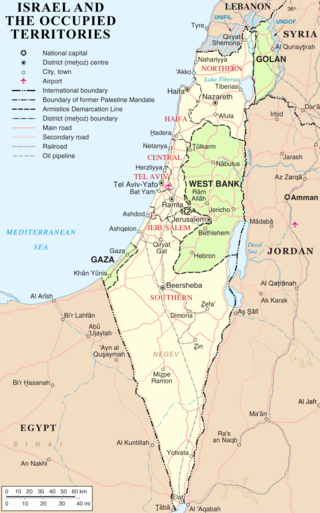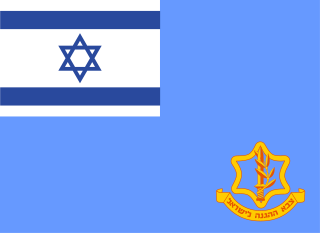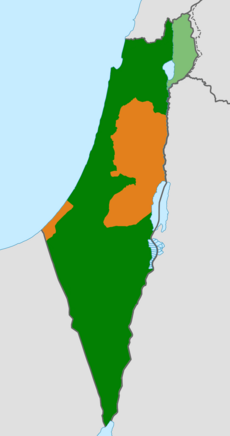
Israeli settlements or colonies are civilian communities where Israeli citizens live, almost exclusively of Jewish ethnicity, built on lands occupied by Israel since the Six-Day War in 1967. The international community consider Israeli settlements to be illegal under international law, though Israel disputes this.

The West Bank is a landlocked territory near the coast of the Mediterranean in the Levant region of Western Asia that forms the main bulk of the Palestinian territories. It is bordered by Jordan and the Dead Sea to the east and by Israel to the south, west, and north. It has been under an Israeli military occupation since the 1967 Arab-Israeli War. Since the Oslo II Accord was signed in 1995, its area has been split into 165 Palestinian enclaves, that are under total or partial civil administration by the Palestinian National Authority (PNA), and a contiguous area containing 230 Israeli settlements into which Israeli law is "pipelined". The West Bank includes East Jerusalem. Israel administers the West Bank excluding East Jerusalem as the Judea and Samaria Area district, through the Israeli Civil Administration.

United Nations Security Council Resolution 242 (S/RES/242) was adopted unanimously by the UN Security Council on November 22, 1967, in the aftermath of the Six-Day War. It was adopted under Chapter VI of the UN Charter. The resolution was sponsored by British ambassador Lord Caradon and was one of five drafts under consideration.

The Palestinian territories are the two regions of the former British Mandate for Palestine that have been militarily occupied by Israel since the Six-Day War of 1967, namely: the West Bank and the Gaza Strip. The International Court of Justice (ICJ) has referred to the West Bank, including East Jerusalem, as "the Occupied Palestinian Territory", and this term was used as the legal definition by the ICJ in its advisory opinion of July 2004. The term occupied Palestinian territory was used by the United Nations and other international organizations between October 1999 and December 2012 to refer to areas controlled by the Palestinian National Authority, but from 2012, when Palestine was admitted as one of its non-member observer states, the United Nations started using exclusively the name State of Palestine. The European Union (EU) also adopts the term occupied Palestinian territory, with a parallel term Palestinian Authority territories also occasionally used. The government of Israel and its supporters use the label "disputed territories" instead.
The International law bearing on issues of Arab–Israeli conflict, which became a major arena of regional and international tension since the birth of Israel in 1948, resulting in several disputes between a number of Arab countries and Israel.

United Nations Security Council Resolution 452, adopted on 20 July 1979, addressed the issue of the Israeli settlements in Jerusalem, the West Bank, Gaza Strip and the Golan Heights, specifically the illegality thereof. It states that "the policy of Israel in establishing settlements in the occupied Arab territories has no legal validity and constitutes a violation of the [Fourth] Geneva Convention relative to the Protection of Civilian Persons in Time of War, of 12 August 1949" and "calls upon the Government and people of Israel to cease, on an urgent basis, the establishment, construction and planning of settlements in the Arab territories occupied since 1967, including Jerusalem."

United Nations Security Council Resolution 471, adopted on 5 June 1980 under Chapter VI of the United Nations Charter was on the issue of the Israeli occupation and settlement activity in the Palestinian territories of East Jerusalem, the West Bank, Gaza Strip and the Golan Heights.

Israeli-occupied territories are the lands that were captured and occupied by Israel during the Six-Day War of 1967. While the term is currently applied to the Palestinian territories and the Golan Heights, it has also been used to refer to areas that were formerly occupied by Israel, namely the Sinai Peninsula and southern Lebanon. Prior to Israel's victory in the Six-Day War, governance of the Palestinian territories was split between Egypt and Jordan, with the former having occupied the Gaza Strip and the latter having annexed the West Bank; the Sinai Peninsula and the Golan Heights were under the sovereignty of Egypt and Syria, respectively. The first conjoined usage of the terms "occupied" and "territories" with regard to Israel was in United Nations Security Council Resolution 242, which was drafted in the aftermath of the Six-Day War and called for: "the establishment of a just and lasting peace in the Middle East" to be achieved by "the application of both the following principles: ... Withdrawal of Israeli armed forces from territories occupied in the recent conflict ... Termination of all claims or states of belligerency and respect for and acknowledgment of the sovereignty, territorial integrity and political independence of every State in the area and their right to live in peace within secure and recognized boundaries free from threats or acts of force."
The status of territories captured by Israel is the status of the Gaza Strip, the West Bank, the Golan Heights, and the Sinai Peninsula; all of which were captured by Israel over the course of the 1967 Six-Day War.

Demographic features of the population of the area commonly described as Palestinian territories includes information on ethnicity, education level, health of the populace, economic status, religious affiliations and other aspects of that population.
Issues relating to the State of Palestine and aspects of the Israeli–Palestinian conflict occupy continuous debates, resolutions, and resources at the United Nations. Since its founding in 1948, the United Nations Security Council, as of January 2010, has adopted 79 resolutions directly related to the Arab–Israeli conflict.

United Nations Security Council resolution 605, adopted on 22 December 1987, after hearing from a representative from South Yemen and recalling the Geneva Conventions and Security Council resolutions 446 (1979), 465 (1980), 497 (1981) and 592 (1986), the Council condemned Israel for violating the human rights of the Palestinian people and in particular the opening of fire and killing of students in the first few weeks of the First Intifada.
The international community considers the establishment of Israeli settlements in the Israeli-occupied territories illegal on one of two bases: that they are in violation of Article 49 of the Fourth Geneva Convention, or that they are in breach of international declarations. The United Nations Security Council, the United Nations General Assembly, the International Committee of the Red Cross, the International Court of Justice and the High Contracting Parties to the Convention have all affirmed that the Fourth Geneva Convention applies to the Israeli-occupied territories.
The United Nations General Assembly Resolution 66/225 of 22 December 2011 was a resolution in which the United Nations General Assembly reaffirmed the right of the Palestinian people and of the population of the occupied Golan Heights over their natural resources, demanded Israel to cease the exploitation, damage, cause of loss or depletion, and endangerment of that natural resources and recognized the right of the Palestinian people to claim restitution as a result of Israeli violation of their rights.

The Israeli Military Governorate was a military governance system established following the Six-Day War in June 1967, in order to govern the civilian population of the West Bank, the Gaza Strip, the Sinai Peninsula and the Western part of Golan Heights. The governance was based on the Fourth Geneva Convention, which provides guidelines for military rule in occupied areas. East Jerusalem was the only exception from this order, and it was added to Jerusalem municipal area as early as 1967, and extending Israeli law to the area effectively annexing it in 1980. During this period, the UN and many sources referred to the military governed areas as Occupied Arab Territories.

Area C is the fully Israeli-controlled and only contiguous territory in the West Bank, defined as the whole area outside the Palestinian enclaves. Area C constitutes about 61 percent of the West Bank territory, contains all Israeli settlements other than those in East Jerusalem, and more than 99% of the area is off limits or heavily restricted for Palestinians. The area was committed in 1995 under the Oslo II Accord to be "gradually transferred to Palestinian jurisdiction", but such transfer did not happen. The area is richly endowed with natural resources.
There are a wide variety of views regarding the legal status of the State of Palestine, both among the states of the international community and among legal scholars. The existence of a state of Palestine, although controversial, is a reality in the opinions of the states that have established bilateral diplomatic relations. It is a non-member observer state at the United Nations since November, 2012. As of 31 July 2019, a total of 138 countries recognize it.
United Nations Security Council Resolution 2334 was adopted on 23 December 2016. It concerns the Israeli settlements in "Palestinian territories occupied since 1967, including East Jerusalem". The resolution passed in a 14–0 vote by members of the United Nations Security Council (UNSC). Four members with United Nations Security Council veto power voted for the resolution, while the United States abstained.

United Nations General Assembly resolution ES‑10/L.23 is a resolution of the Tenth emergency special session of the United Nations General Assembly criticizing the Israeli response to the 2018 Gaza border protests. The resolution was sponsored by Algeria, Turkey and the State of Palestine passed with 120 voting in favour, 8 against, and 45 abstentions.











